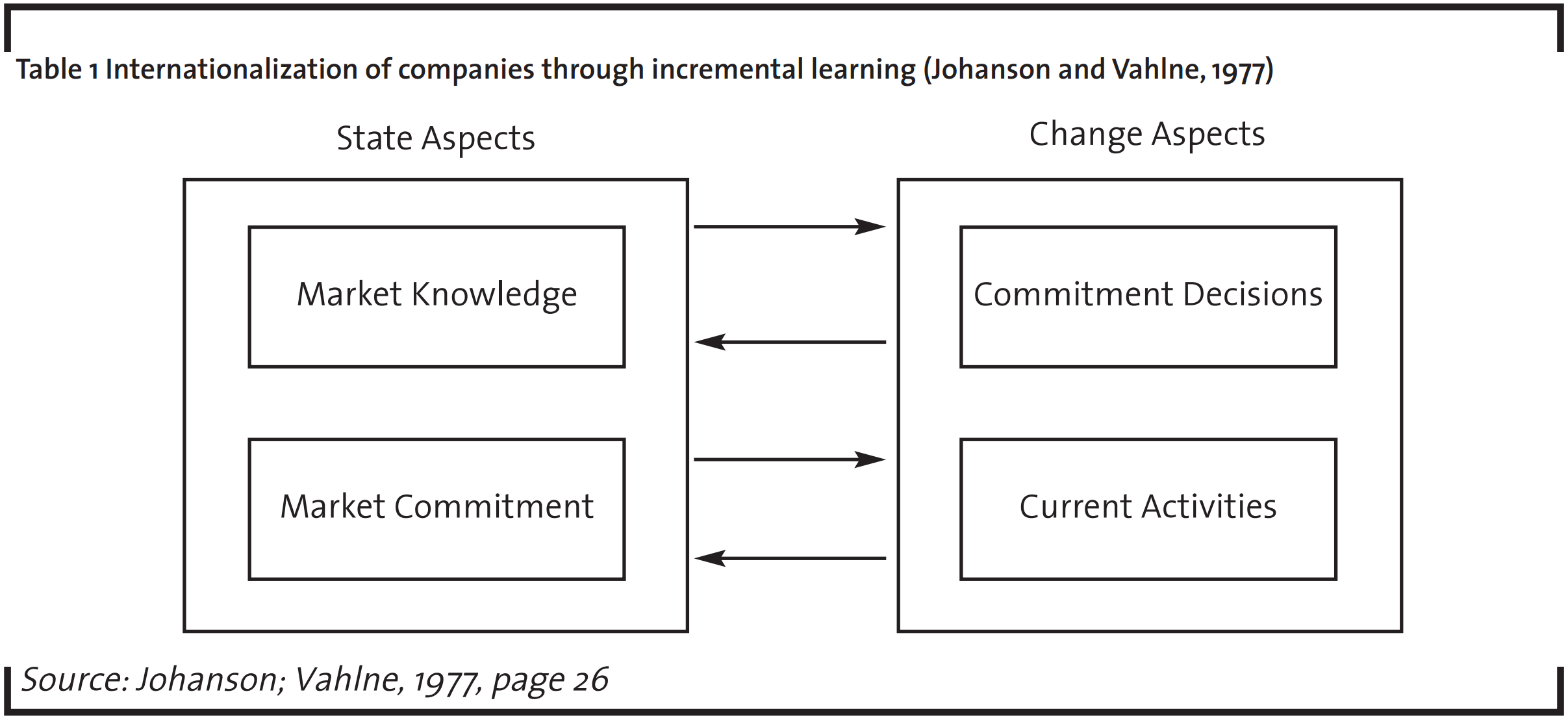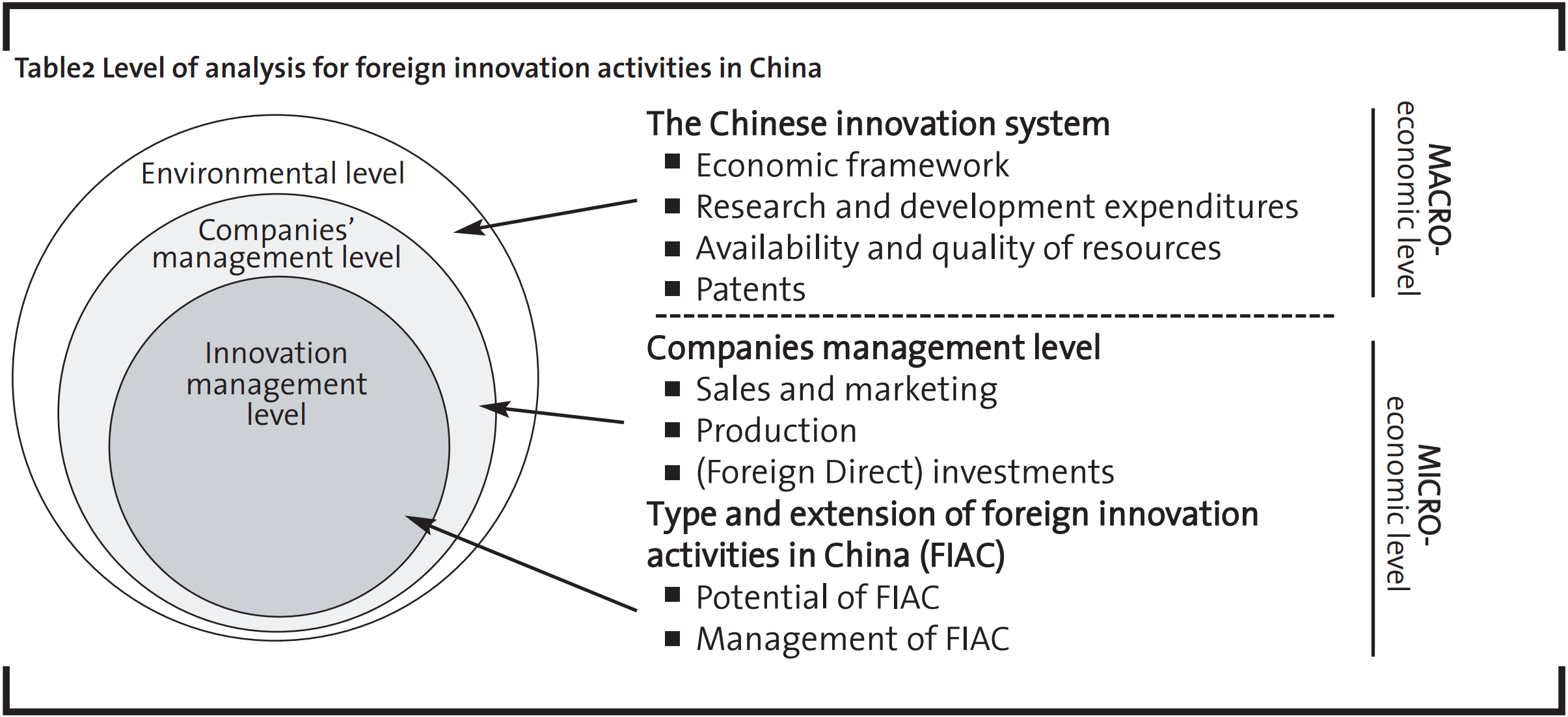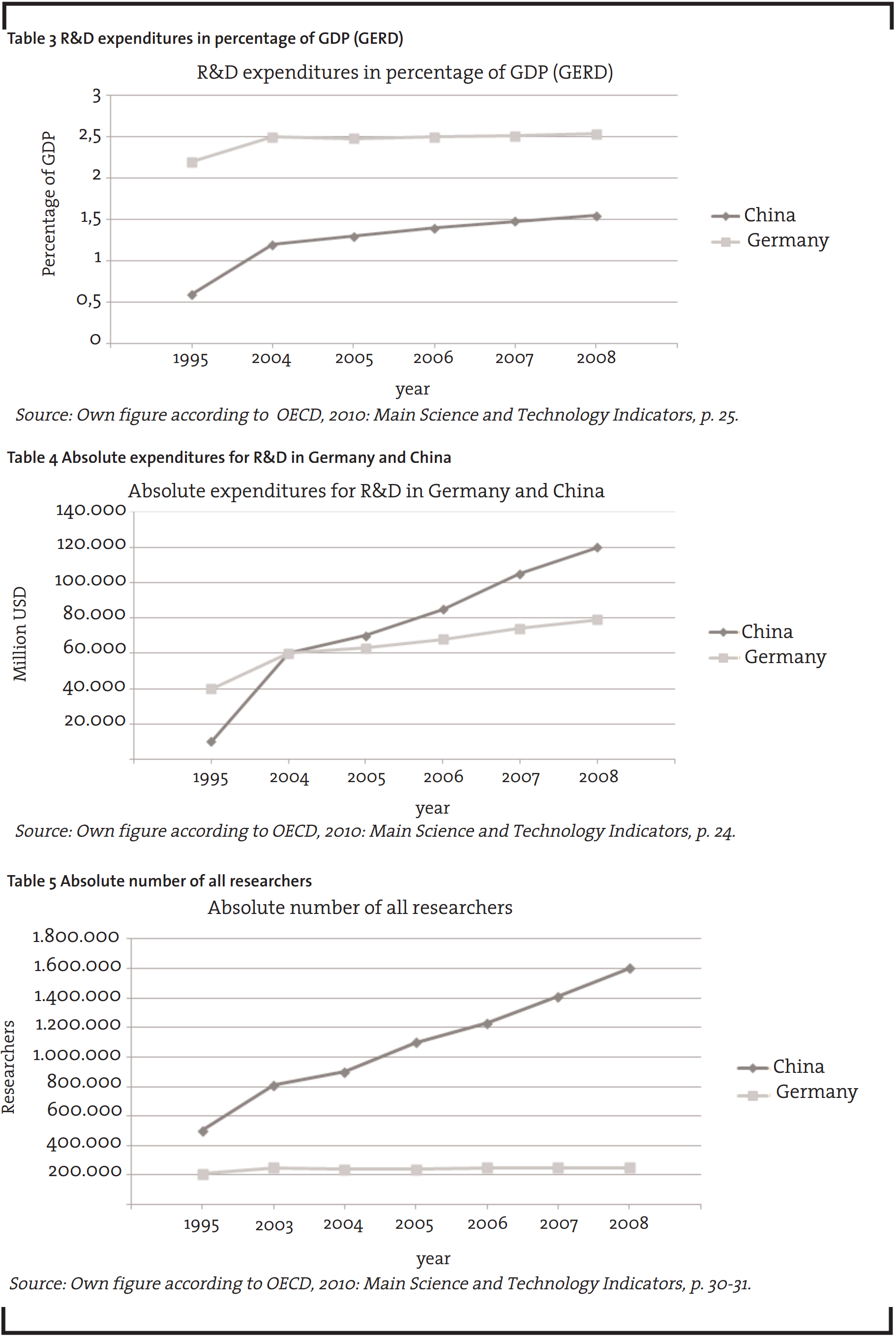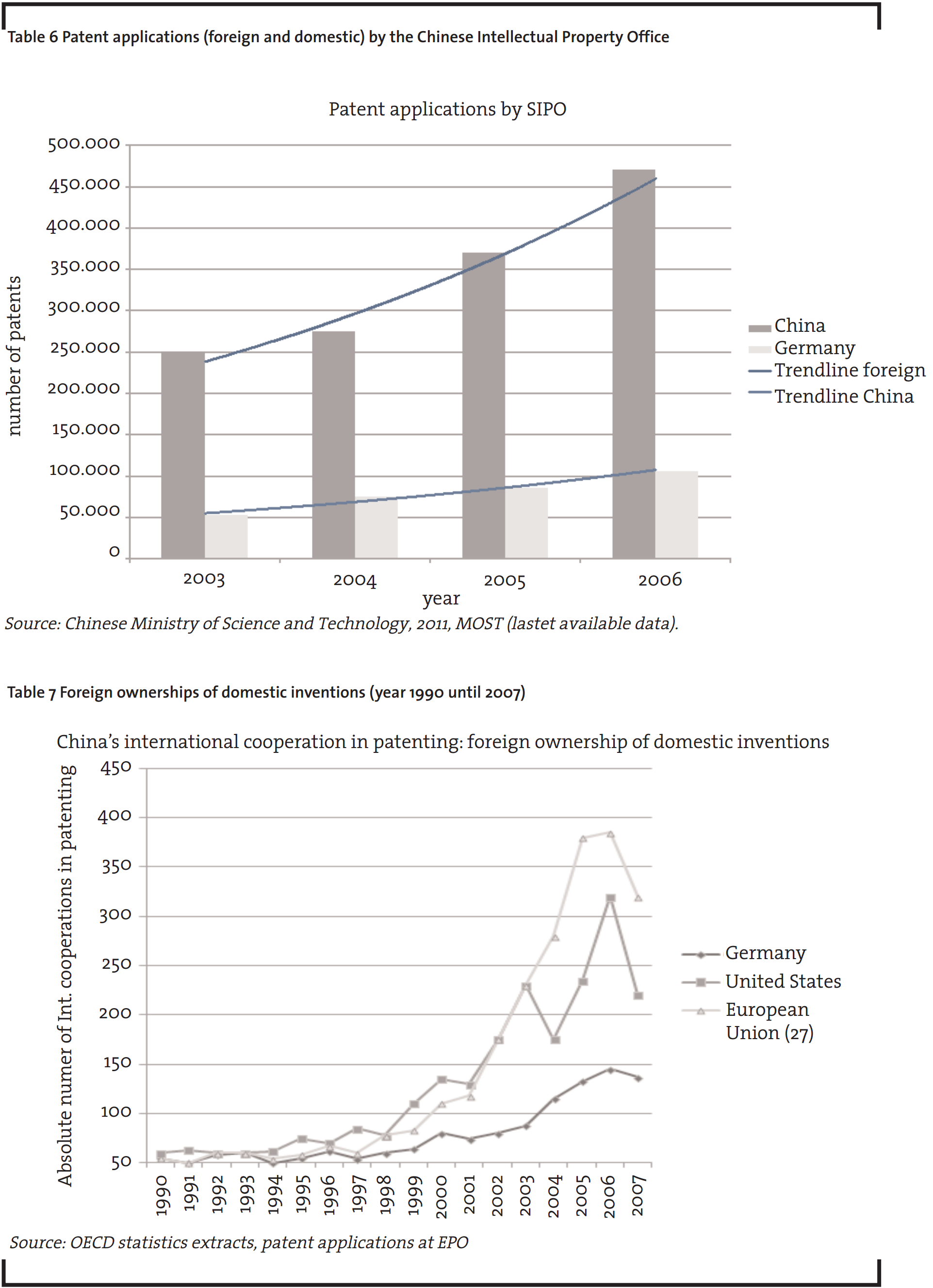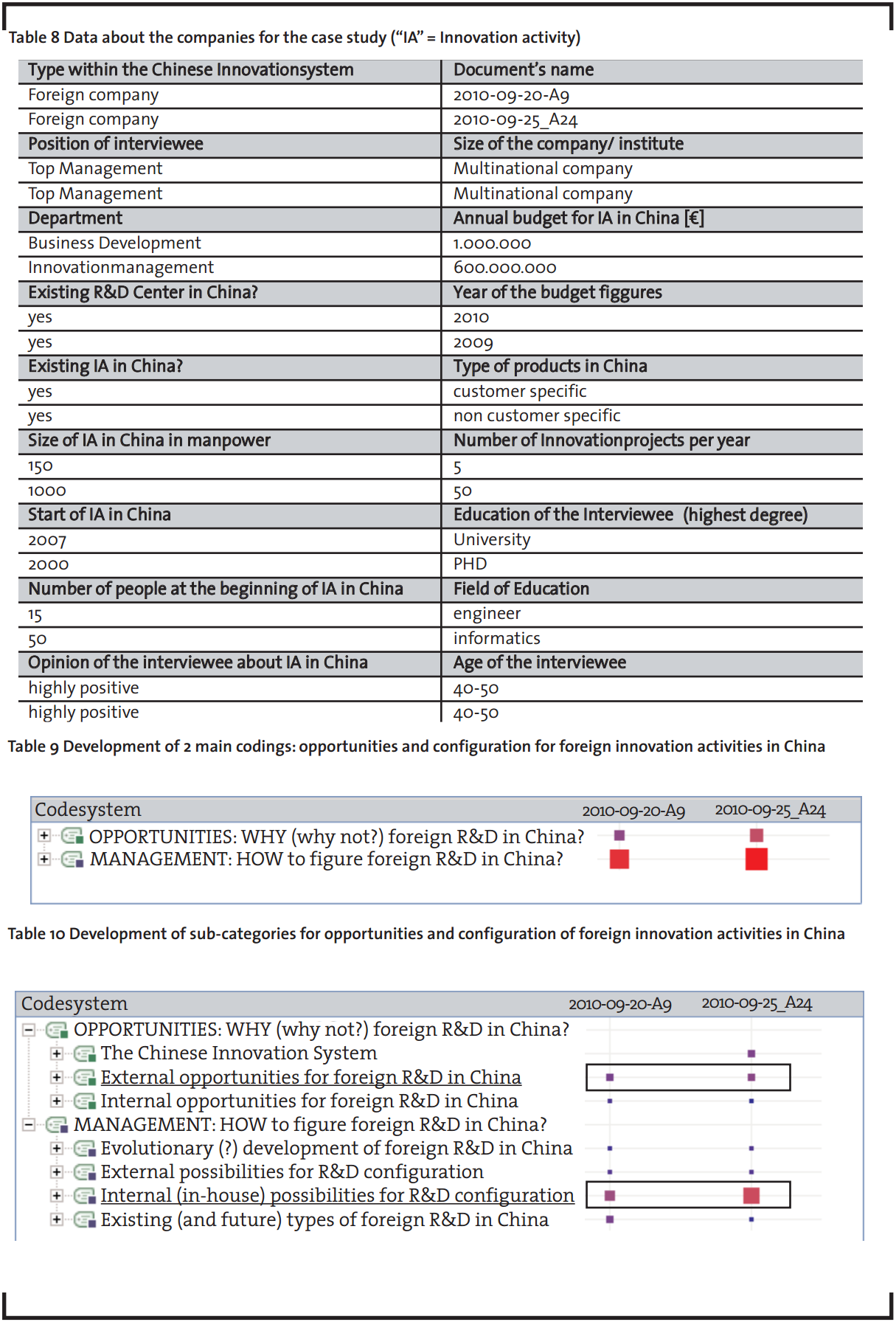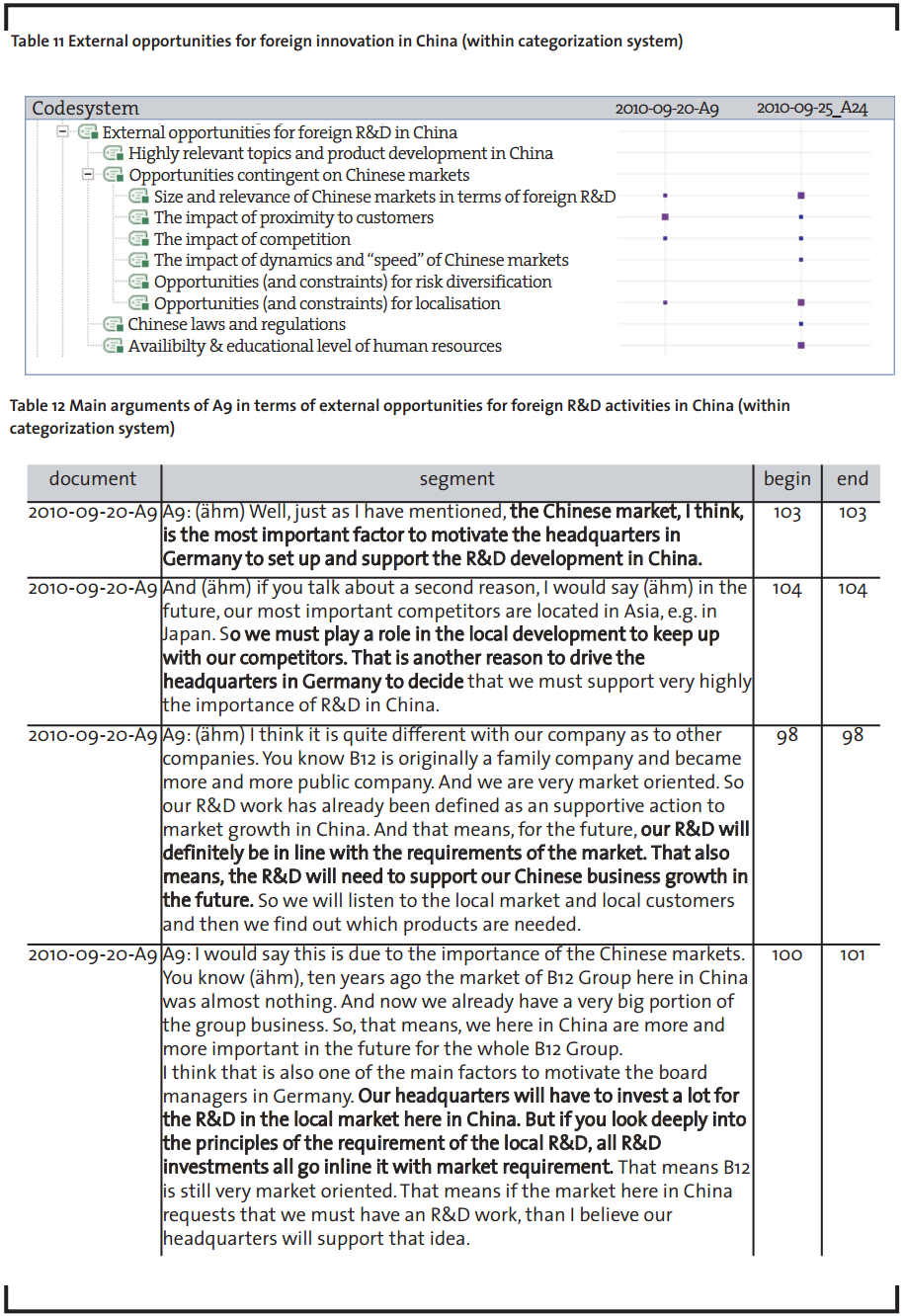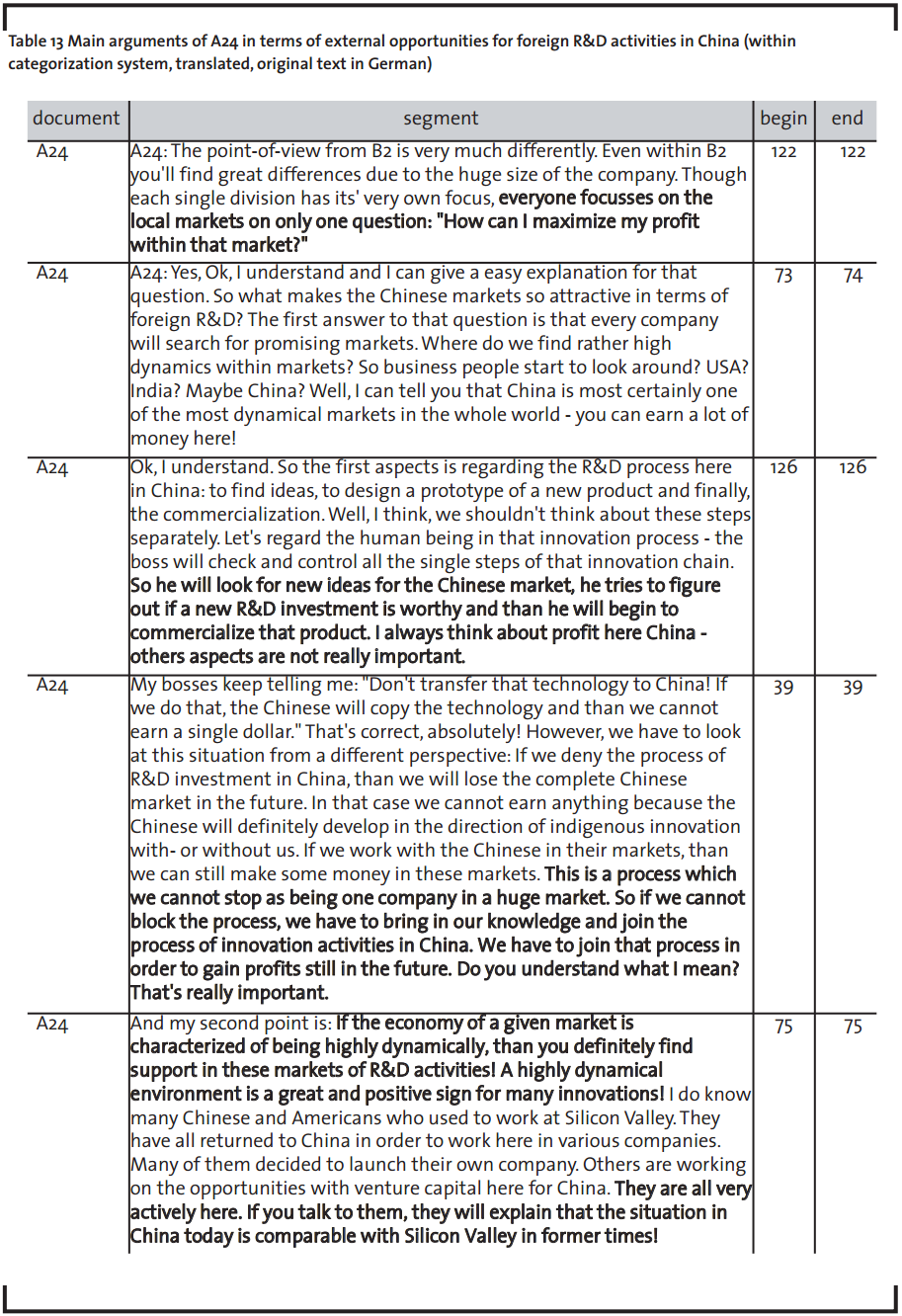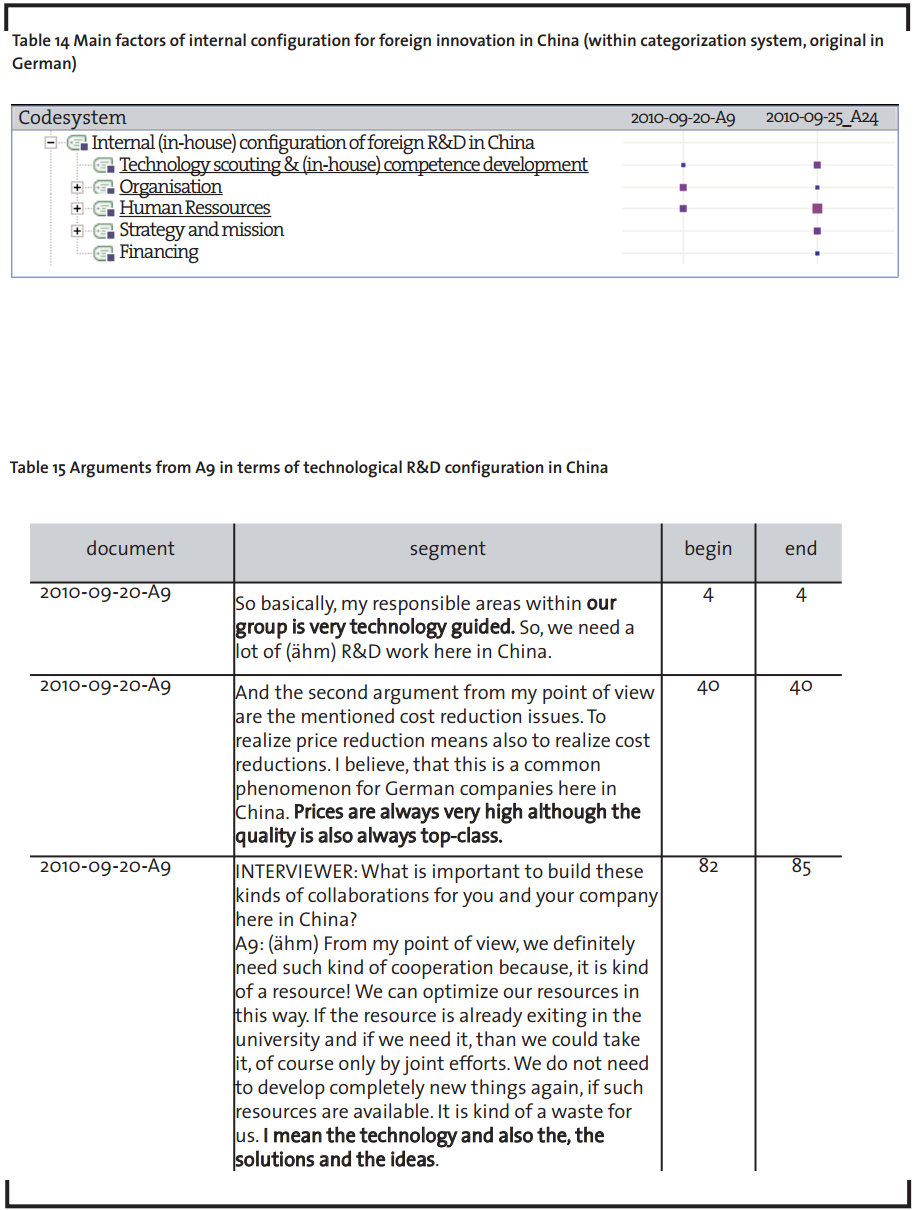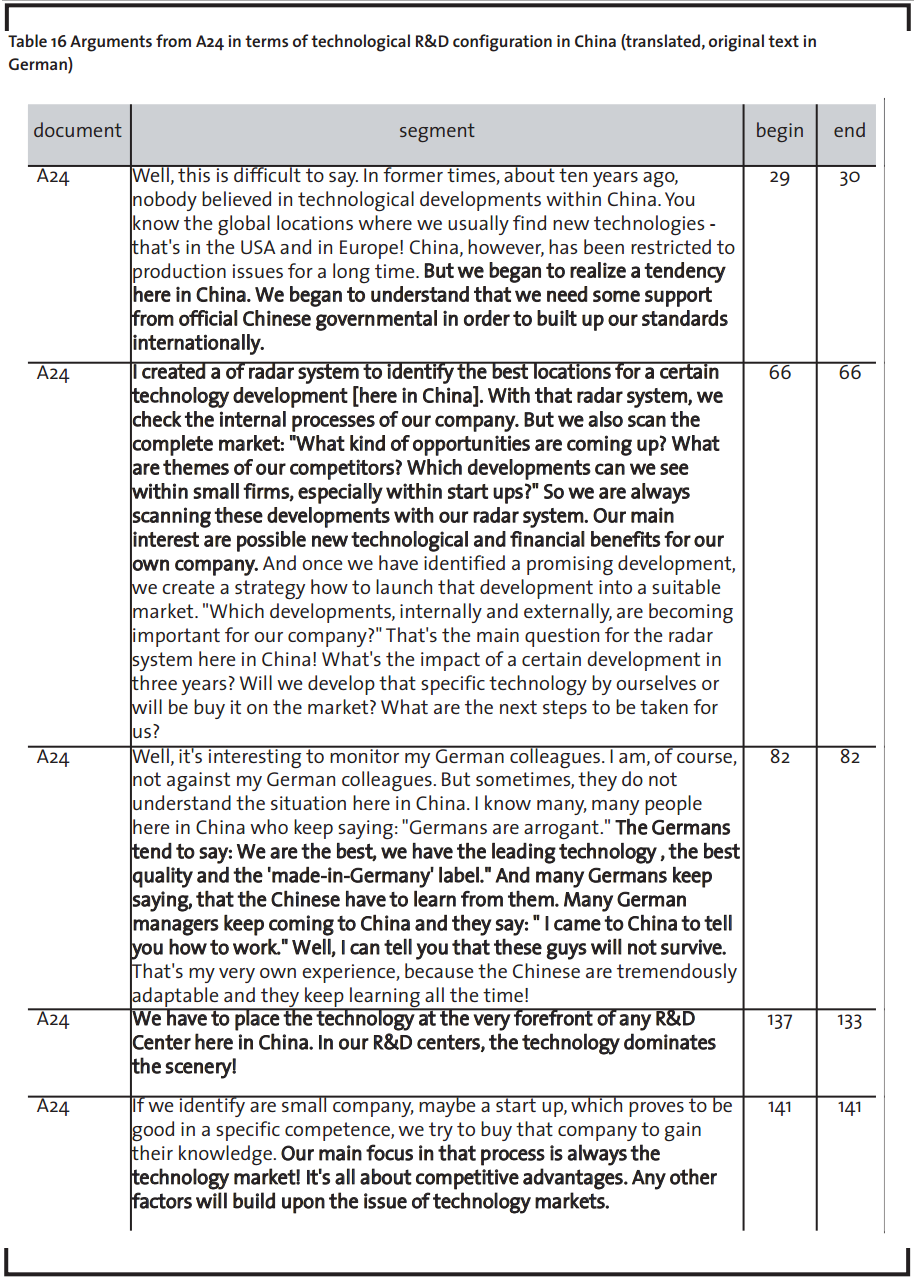Opportunities for- and configuration of foreign innovation: a case study of multinational companies in China
Abstract
China has made significant progress in terms of economic development and market based reforms within the last twenty years. The country is no longer limited to a cheap production location for the rest of the world. It became a promising market with expanding capabilities for foreign direct investments (FDI) and new product development (NPD).Though Chinas NPD potential is being recognized, our knowledge about NPD-processes of foreign companies in China remain scarce. This paper contributes to research limitations about foreign innovation management in China. After a short literature review about international innovation management with a special focus on China, we present a secondary data analysis about innovation activities in China from a macro-economical perspective. We use actual data from the OECD and others to develop this macroeconomic framework about China as a (possible) place for innovation. Secondly, we augment this macro-economical perspective by a functional management perspective. We tackle the how- rather than the if-questions of foreign innovation management in China. These questions have been neglected in current research. Based on existing evidence about innovation activities of foreign companies in China we develop a case study about two German companies in China. The first company has just begun with it’s innovation management in China. The second company has more than ten years experience with innovation management in China. Both companies are highly successful with their activities in China as indicated by growth rates and annual R&D budget. By comparing these two companies, we gain insights about the focus of foreign innovation management in China. We develop managerial implications for foreign companies operating inChina according to maturity of their innovation management.
Introduction
Traditionally, China is no place for innovation. The country had been isolated for the rest of the world until the end of the 70’ties; intellectual property right (IPR) protection is still limited; many of the countries’ scientists have not (yet) reached international qualification standards; most Chinese researchers speak Chinese only and cultural differences between ‘the west’ and China couldn’t be greater (Zedtwitz et al., 2007). So, why would any researcher or practitioner tackle aspects of innovation in China?
The answer seems to be simple and challenging at the same time: China changes its future growth plans from simple technology transfer and mass production towards indigenous innovation. It began to ‘climb up the value chain’ which will eventually lead to more complex and more technology-advanced products and higher capabilities. (Howell et al., 201 0; Schaaper, 2009; ChinaDaily, 2010; Boutellier et al., 2008). Considering, that innovation has been identified as a main element for sustainable and competitive growth for any country and company (UNCTAD, 2010a; Buckley and Casson, 2009; Schumpeter, 1936), China most certainly began to set promising priorities for its future. Combining Chinas indigenous innovation activities with the market size of 1.3 billion consumers, provides interesting opportunities for both, researchers and practitioners. Not surprisingly, Boutellier et al. (2008) explain that China becomes nowadays one of the most promising future markets for innovation.
However, our knowledge about China as an innovative nation remains limited for three reasons. Firstly, China had been closed for the rest of the world until the late seventies. Access to information from outside scholars was not possible (Simon, 2007). Secondly, access to the nations’ technological development plants is still highly restricted and mostly not compatible with OECD standards. Thirdly, existing studies about international innovation management still concentrate on the triade regions (USA, Europe and Japan); not on emerging markets such as China. In fact, any innovation activity in China is in an early development stage and the nation has only recently began to focus on indigenous innovation (Simon, 2007; UNCTAD, 2010b; Liu, 2008).
Consequentially, studies about (foreign) innovation in China are scarce. The few existing studies are descriptively (Boer et al., 1998), not analytically. They also focus more on macroeconomic perspectives (Walsh, 2003; Simon and Cao, 2009). HAN (2008) explains: “(…) the body of knowledge on managing foreign R&D [research and development] in China is still in its infancy, considering the limited amount and scattered focus of academic contributions.”
In this paper, we contribute to filling this research gap. We will introduce the issue of innovation activities in China from a foreign companies’ perspective. We offer a conceptual and empirical study about innovation management of multinational companies operating in China. As theory in international (innovation) management always suggests integrating environmental specifics (Dülfer, 1982; Macharzina, 2010), we include a macroeconomic analysis of the Chinese innovation system.
Theoretical framework
In this section, we will provide a structured overview about existing studies and adequate theoretical perspectives about our research focus. This approach will eventually lead us to our research questions.
Most existing studies about international innovation concentrate on macroeconomic perspectives within the traditional triad region (USA, Europe and Japan). These studies deal with the level of international R&D activities and its impact on socio-economical issues within a national scale (Meyer-Krahmer and Reger, 1996; OECD, 2010b; UNCTAD, 2005; UNCTAD, 2010a; Narula and Zanfei, 2005; Belitz, 2010; Cantwell, 1995). For example, Narula and Zanfei (2005) concentrate their research on the dominating role of multinational enterprises (MNE) within global research and development activities. Belitz (2010) focuses on the R&D internationalization of German MNE based on patent data. Mansfield et al. (1979) integrates the perspective of international R&D activities from a US-point of view. Some studies focus on international innovations from a microeconomic perspective. They explore the management of innovation of companies within a foreign country. For example, Gassmann (1997) explored the framework, the opportunities and the organization of international R&D projects based on 89 personal interviews. Reger (1997) explored the coordination and strategic management of international innovation processes based on four case studies and additional secondary data. Recent studies include the work of Gassmann and Keupp (2005) who focus on motives, organization and human resources within international innovation activities.
Few studies concentrate on innovation activities in China, being an emerging market (Von Zedtwitz, 2004; HAN, 2008). Most of these studies focus on a macroeconomic perspective. For example, Walsh (2003) describes the increasing innovation capabilities in China. He concludes after 36 interviews, that Chinese innovative capabilities are likely to become important for the rest of the world in the nearby future. Huang et al. (2004) analyze the general political and social framework conditions for innovative growth in the Chinese nation. Based on a literature review and secondary (national) data, the authors identify five categories for Chinese major innovation policy demands (similar: Liu and White, 2001). Simon and Cao (2009) help us to gain valuable, but also macroeconomic orientated data about the development of (high qualified) human resources in China. Bielinski (2010) analyzes China as a possible place for R&D from an economical-geographical point-of-view. Schaaper (2009) develops OECD-related indicators to measure the Chinese national innovation system which remains highly in-transparently for researchers outside of China.
These studies provide us with a basic understanding about the framework conditions for innovation in China. However, questions about the (functional) management of (foreign) innovation in China remain largely unanswered.
The few existing studies which focus on a micro-economical perspective can be categorized into (1) Chinese or (2) foreign companies innovation management. For example, Boer et al. (1998) developed a case study to identify challenges of a Chinese Central Iron & Steel Research Institute. Xue and Tschang (2005) analyzed the structure, development, and determinants of the Chinese software industry by conducting 34 interviews within Chinese companies. Studies focusing on foreign companies, remain rather descriptively than analytically. For example, Gassmann and Han (2004) conducted 18 interviews with R&D manager to explore general challenges of foreign R&D activities in China. Von Zedtwitz (2004) identified by conducting 37 in-depth interviews, main tasks, locations and organisational forms of R&D activities from multinational companies in China. HAN (2008) identified by about 100 interviews that R&D professionals, intellectual property rights and cooperation with Chinese universities are the main managing tasks for any foreign companies’ R&D activity in China.
Moreover, most of these studies are not based clearly, on economical theories. For example, Boer et al. (1998) summarize main challenges for R&D managers in China. He suggests to “apply Western R&D management theory in China” in the future (Boer et al., 1998, p. 195). Newer studies, like HAN (2008) provide insights into foreign companies’ R&D activities in China. Han recommends the integration of strategic management theories in future research. The paper from Zedtwitz et al. (2007) investigates motives, growth and locations of foreign R&D in China but does not relate to economical theories. Other studies do not mentioned theoretical approaches at all (Walsh, 2003; Wu, 2000).
The rareness of management theories within (foreign) innovation management in China may be explained by the novelty of the research subject. As indicated in our introduction, China had been closed for the rest of the world until the late seventies. Since the eighties, China began slowly with market based reforms (Fischer and Von Zedtwitz, 2004, Walsh, 2003; Piotti, 2009). Only recently, China began to ‘climb up the ladder’ in terms of technological advanced production. Such settings require an explorative research method in order to find (not to test) causalities and theories.
To our understanding, Johanson and Vahlne (1977) from Uppsala School provide an adequate model within the research context for the following reasons. According to the model of Johanson and Vahlne (1977), companies begin internationalization by export. If the company gains positive export experience (e.g. market shares), it will expand its foreign market commitment by foreign production and, eventually, by foreign innovation activities. Johanson and Vahlne (1977) explain this process of internationalization by an incremental learning curve in foreign markets as illustrated in table 1.
In fact, most foreign companies begin internationalization towards China with sales and marketing (Walsh, 2003; Piotti 2009). They continue to internationalize their activities by the construction of production plants in China (Liu, 2008). Today, foreign direct investment (FDI) is rising significantly. China receives nowadays the second-largest amount of worldwide foreign direct investments (UNCTAD, 2010b). Hence, foreign companies started incremental innovation activities, e.g. quality assurance within existing Chinese production lines or incremental product adoptions according to Chinese customers’ demands. Since 2000, the number of R&D-centers increased almost constantly (Sigurdson, 2005; FAZ et al., 2008; Walsh, 2003; Festel et al., 2005; Boutellier et al., 2008; HAN, 2008; Von Zedtwitz, 2004). For example, HAN (2008) found evidence about 800 foreign R&D centers in China; the OECD (2007) lists 750 centers.
Research questions and methodology
As specified in our theoretical framework, existing studies about international innovation management in China are scare. They tend to be rather descriptively than analytically and they concentrate on macro-economical (national or regional) rather than micro-economical perspectives like the functional management of innovation within companies. Nevertheless, existing studies identify research limitations and develop our own research framework. Hence, our research question is:
How do foreign companies manage their innovation activities within the specific Chinese environment (Potentials and confguration of foreign innovation activities in China)?
We begin our analysis with a macroeconomic perspective to gain a basic understanding about the Chinese innovative environment. Understanding a foreign environment, is an important requirement in international management theory (Dunning and Lundan, 2008; Grant and Nippa, 2006). By using these macroeconomic insights, we aim to learn more about opportunities for and configuration of foreign innovation activities in the specific Chinese environment.
Based on that macroeconomic perspective, we continue our analysis with a microeconomic perspective. As analyzed in our theoretical framework, it remains unclear, if and how foreign companies benefit from Chinas development towards innovativeness. Hence, we aim to explore within our microeconomic perspective the functional management of innovation from foreign companies which operate in China. Both perspectives, micro- and macro, have a coherence which we illustrate in the next table.
Table 3 illustrates three possible level of analysis: the environmental level; the companies’ level and the innovation management level within the company. In this paper, we focus on the environmental-, and the innovation management level. We do not analyze the companies’ general management level (including foreign direct investments), because the literature already provides a broad range of studies about this issue.
Regarding our methodology, we firstly collected secondary data provided by the Organisation for Economic Co-operation and Development (OECD) and by the European Patent Office (EPO). The collection of these secondary data allows us to understand the environment for foreign innovative activities in China according to the table above. Secondly, we collected primary data in China according to our research interest. We did not use a quantitative approach to collect primary data because innovation activity in China is a relatively new phenomenon that points out an explorative (see theoretical framework). Hence, we do not test existing theoretical evidence to identify causalities (‘relation-orientated method’) but we aim to identify causal mechanisms (‘mechanism-orientated method’)1. We find evidence in the literature that supports this methodology. For example, HAN (2008) explains that future explorative studies are necessary in order to understand the under-researched field of global R&D investment within emerging markets. Boutellier et al. (2008) conclude that qualitative methods (especially semi-structured in-depth interviews) are purposive for research on foreign R&D in China.
Based on existing theoretical evidence about international innovation in China, we designed an interview guideline to arrange one-hour semistructured in-depth interviews with foreign companies in China. Central questions included the description of the interviewees working environment especially in terms of innovation activities in China; the development of the Chinese innovation system from a foreign companies’ perspective; the collaboration and/ or cooperation between foreign companies and Chinese universities in terms of innovation and the functional management of innovation activities in China (past, today and future, including organizational and human resource aspects).
We recorded all interviews and transcribed them afterwards, resulting in 1300 pages of data for further qualitative analysis. After transcription, we made all personal data anonymously. This has been an important postulation to create a trustful interview atmosphere and to get valuable information from each interviewee. After anonymization, we imported all data in MAXQDA for further analysis. We structured our data by the development of a coding system (Mayring, 2010a; Gläser and Laudel, 2009). We use our previous understanding about international innovation activities to build a first (theoretical-based) coding system within MAXQDA. We added this theoretical-based coding system with our findings within the interviews by complementing, specifying, and adding (sub-) categories. Consequentially, not use the grounded theory approach, because we have a previous understanding about international innovation activities. From a data triangulation point-of-view, we included 20 (string and numerical) variables mentioned during the interviews. These variables help us to validate answers of the respondents (e.g. in terms of years of experience with innovation activities in China of the interviewee).
Data collection
For secondary data collection, we used the Main Science and Technology Indicators (provided by OECD) and patent data from the EPO. To some extent, this becomes difficult because China does not always follow OECD guidelines, especially in terms of R&D (OECD, 2008). Thus, we limit our indicators to available data such as growth domestic expenditure for R&D; human resources in R&D as well as patent data. Moreover, we concentrated on data about researchers, not on R&D personnel. According to the Frascati Manual, researchers are experts in terms of innovative activities, whereas R&D personnel includes also supportive and administrative staff for research activities (OECD, 2002).
For primary data collection, we arranged semi-structured-in-depth interviews between September and November 2010. With respect to time and financial restrictions, we concentrated our data collection on the greater area of Beijing. Beijing and Shanghai are the main centers for (foreign and local) innovation activities in China (Von Zedtwitz, 2004, Greatwall, 2002). We crosschecked our location preferences by the German Company Directory (GCD). The GCD is a database, powered by the German Chamber of Foreign Trade, which lists more than 4.300 German companies in China, sorted by location and industry type. According to that database, most German manufacturing companies are located in the greater area of Beijing or Shanghai.
Our target group of possible interview partners have been German companies in the industrial (manufacturing) sector. We eliminated the service sector because characteristics of these industries are too different from the manufacturing sector. We decided not to specify one certain industry-type as the possible unit of adequate interviewees is limited due to the novelty of foreign innovation activity in China. Furthermore, literature does already provide case studies from one company about R&D in emerging markets (for the case of General Electric: Dubiel (2009); for different, single company-based cases about global innovation management: Boutellier et al. (2008)).
We extracted the number of relevant branches within the manufacturing industry by the following key indicators. Firstly, we chose only industry types with a high Ievel of international R&D activities. According to Belitz (2010), the German chemistry-, pharmaceutical, machine-building- and the automotive industry have the highest degree of international R&D activities within all German manufacturing industries. The classification of OECD (1997)presents similar results for all OECD countries. Secondly, we chose industries, which are more likely to grow in China due to the Chinese’ government plans. The Chinese government recently announced to strengthen its own innovation capabilities (indigenous innovation) by a special strategic promotion of the foreign and domestic high- and medium-tech industries (Schaaper, 2009). Such a governmental promotion (e.g. by tax incentives and adequate infrastructure) may result in a technology pull for overseas medium- and high-tech industries towards China. In fact, many high-tech companies, such as BASF, SIEMENS or MOTOROLA already have R&D units in China and they plan to increase these activities in the nearby future (Boutellier et al., 2008, Wuttke, 2005). Hence, we focused on the German chemistry-, pharmaceutical, machine-building, and automotive industries for data collection. Within these specific industries, we concentrated only on companies that have an R&D center in Germany and which also have (or at least plan) innovation activities in China.
We used three main communication channels to identify suitable interviewees within our predefined target group. Firstly, we had exclusive access to the German Company Directory by the German Chamber of Foreign Trade. We filtered the existing 4.300 German companies in the database according to (1) our preferred industry and according to (2) location as stated above. Next, we invited 150 companies named in the database to join our research project. We came up with only 6 participants (response rate: 4%). The low response is not surprising given the sensitivity of the research subject (innovation activities in China) and the importance of ‘Guanxi’ in China. Han (2006) explains: “Most of the companies are not willing to reveal deep insights into their R&D strategy and issues in China” (Han, 2006, p.16). Secondly, by building up our own Sino-German research network, we gained another 26 participants for personal interviews in the greater area of Beijing. Thirdly we gained a ‘snowball-effect’ during data collection phase in Beijing. We asked each interviewee for additional possible interviewees within his or her own network to join our research project. As each interviewee became familiar with the interviewer and the research topic itself, the acquisition of new interviewees was high (about 33%). We continued to collect data after two month in Beijing by phone conferences from Germany to China. Successful phone conferences have been almost entirely recommendations by former personal interviews in China. The acquisition of new interviewees for Sino-German phone conferences was close to zero percent due to the sensitivity of the research subject and the lack of geographical proximity. In total, we came up with 42 exploitable interviews.
We invited each possible interview partner by phone and by e-mail to join our study. We explained in letter our research focus and we described suitable interview partners (e.g. ‘we are looking for innovation and/or business development managers from German manufacturing companies operating in China’). To build up a trustful relationship between the interviewer and the interviewee, each interview lasted minimum one hour. Building a trustful relationship is one of the most important presettings to secure adequate information flow from the interviewee to the interviewer (Mayring, 2010b).
Findings next
Secondary data findings
Based on our secondary data analysis, we find support for Chinas rise of innovation capabilities.
For a structured analysis, OECD and other sources suggest an input-output model to measure a countries’ innovativeness (Grupp, 1997; Diez and Kiese, 2006; Schaaper, 2009). Thus, we begin our secondary data analysis with available input indicators (Chinese growth domestic expenditure for R&D and human resources in R&D), followed by Chinese patent activities as an available output indicator.
The Growth Domestic Expenditure for Research and Development (GERD) is an important and available input indicator. GERD in China has been risen from 0.5% in 1995 up to more than 1.5% in 2008 OECD (2010b). Even though this rise is significantly, it is still below of must OECD countries (table 3).
Our next input indicator is the level of Chinas’ absolute R&D expenditures per year. It does not surprise, due to the nations geographical dimensions, that China already exceeded Germany since 2004 (table 3).
The next input indicator is the absolute number of human resources in research areas. This indicator does also support the hypothesis of Chinas’ sustainable growth of innovative capabilities (table 5).
Regarding output-indicators we used patent data only. Other, reliable data about China are scarce within OECD-database and official Chinese ministry websites (Bielinski, 2010).1
The Chinese Ministry of Science and Technology (MOST) provides data about patent applications in China (table 6). By collecting these data within a four-year-period, we are able to identify a positive trend of patent applications in China. Moreover, there is a significant difference between the strong rise of Chinese (red) and foreign (grey) patent applications. Some authors explain this difference by the level of sophistication (Gassmann, 2008). Foreign patent applications tend to be “real” inventions whereas Chinese patent applications tend to be rather design and model orientated.
Moreover, the patent indicator “foreign ownership patents of domestic inventions” (FOPD) provides insights about foreign innovativeness in China (table 7). This indicator has been risen significantly since the turn of the century (OECD, 2010a).
The European Patent Office (EPO) counts 2.000 of FOPD by the year 2007.2 Even though the rise of these patents is high, its level is still low within international comparisons.
Primary data findings
Based on our available primary data, we have chosen two multinational companies for a comparative study. Both companies belong to the manufacturing industry, they have a German origin and they are highly involved in innovation activities in China. Both companies have truly positive experiences in terms of the research subject. However, one multinational has just started innovation activities in China three years ago; the other multinational has more than ten years of experience with innovation activities in China. As such, we are able to analyse innovation activities of a foreign company in China in an early stage of development (‘A9’ with three years of experience) in comparison with an established foreign R&D center (‘A24’ with ten years of experience).
A9 has risen its’ number of R&D personnel in China from 15 people to 150 people in only three years. The company has an annual budget for R&D activities in China of one million Euros. The second multinational, A24, has ten years of experience within innovation in China. A24 introduced R&D activities in China by the year 2000 with 50 employees. Until 2009, it has risen its’ R&D staff up to more 1.000 employees and an annual R&D budget above 500 million Euros (5 billion yen). Both multinationals evaluated foreign R&D in China as highly positive and important for the companies’ future strategy. We summarized more data about both multinationals in table 8.
In line with qualitative data analysis (as explained in the chapter “methodology”), we developed a coding system based on existing theoretical evidence and empirical data. Hence, we developed two main categories: Opportunities for German industrial companies within the Chinese innovation system (following the macroeconomic approach) and configuration of foreign innovation in China (following the microeconomic approach in terms of functional management).
The absolute number of codings within each interview indicates a first relevance of the interviews’ content. As indicated in the table below, both interviewees, from A9 and A24, concentrated on the configuration of foreign innovation in China in their statements (microeconomic perspective). A24 dominated the arguments, which is not surprisingly due to the companies’10 year R&D experience in China (see table 10).
By developing sub-categories, we are able to analyse opportunities and configuration of foreign innovation in China in greater detail (see table 10).
Within the first main category opportunities, we can distinguish between three subcategories:
- the position of foreign companies within the Chinese Innovation System,
- internal opportunities for foreign companies operating in China (in terms of R&D),
- external opportunities for foreign company operating in China (in terms of R&D).
Within the second main category configuration, we can distinguish between four sub-categories: (see table 10)
- (evolutionary) development of foreign R&D in China,
- external management of foreign innovation in China (e.g. industry-university cooperation),
- internal management of foreign innovation in China (e.g. organ-isational forms and human resource management)
- typologies of foreign innovation activities in China
Using a code-matrix relational analysis, we identified external opportunities to be more relevant than internal opportunities (yellow labels in the table above). Furthermore, we identified internal configuration to be more important for multinationals than external configuration (table 10). Thus, we focus our further analysis on external opportunities and internal configuration of foreign innovation activities in China.
a) External Opportunities of foreign innovation activities
Regarding external opportunities, we compared A9 and A24 to find similarities and differences for successful foreign innovation in China.
Both multinationals (A9 and A24) have emphasized that the market is the main motivation to enhance R&D activities in China. Both companies underline the existence of great opportunities within the Chinese market for current and future innovation activities. We summarize the main arguments of A9 and of A24 in table 12 and 13.
According to table 12, A9 has some innovation activities in China so far, however, the potential is not yet fully developed.A9 indicates that it still need to become independent from their German headquarter in order to fully participate from Chinese innovative (market-) developments. A9 is trying to convince its’ headquarter in Germany to put more emphasis on innovation activities in China due to the requirements of the Chinese markets. On the contrary, the argumentation of A 24 is more sophisticated as indicated table 13:
A24 is an active innovation player in China for more than ten years. Their main focus is not (any more) to convince its’ headquarter in Germany to support innovation activities in China (as A9), but to maximize profits in China by localization The interviewee states, that China is one of the most dynamic markets in the world which eventually will lead to innovation activities. Even though China may not be capable enough today for all kinds of innovation activities, China will eventually become one of the leading innovators of the world, according to the interviewee. A29 strongly emphasises (far more than A9), that foreign companies need to localize innovation activities in China to remain competitive and to become fully integrated into the dynamical Chinese markets. Though the interviewee admits, that knowledge from foreign technologies can in fact get lost to Chinese competitors during the process of localization, foreign companies will eventually lose the total Chinese market if they don’t localize R&D.
We will discuss these two different argumentation lines of A9 and A24 within the chapter discussion.
b) Internal configuration of foreign innovation
Within internal configuration of foreign innovation activities in China, we identified technology (-scouting); human resources and “organization” as key aspects. In this paper, we will focus on the aspect of technology. (An analysis of all other key aspects like organization and human resources seems likewise interesting, but too comprehensive for one paper).
Even though both companies explain that the technology is very important for innovation in China, their managerial focus remains quite differently.
A9, being the company with less experience in China, is a highly technology orientated company. Being technology-guided, A9 introduced innovation activities in China mainly to reduce costs when redesigning products for the Chinese market. By redesigning its’ products, the company reduces costs of the products to remain competitive while keeping standards high quality. A9 explains that cooperation with local universities is also important to enhance (cost-driven) product development. We present main quotations of A9 about the technology aspects in table 15.
On the contrary, A24, having ten years of innovation experience in China, does not enhance technological capabilities in China due to cost reasons. Their innovative activities in China are focused on a ‘technological radar system’ which aims to identify new technology developments in China. According to A24,foreign companies should increase their technical capabilities in China because the nation is likewise increasing its’ innovative capabilities significantly. Consequentially, foreign companies are well advised to catch up with Chinese innovation developments by enhancing their own ability of ‘technology scouting’ in China. After ten years of experience, A24 explains that only the development of technological capabilities will eventually lead to competitive advantages for foreign companies operating in China. We present some quotations of A24 in table 16.
To sum up, both companies focus on technology issues within innovation management in China. However, A9, being in an early stage of innovative activities in China, uses technology issues mainly to reduce costs (and market-price) of its’ products for the Chinese markets. On the contrary, A24, being in a mature stage of foreign innovation management in China, ‘scouts’ technology developments in China and tries to integrate relevant aspects into the companies’ overall strategy to stay competitive (absorptive capacity).
Discussion
Based on our secondary data analysis, we found significant evidence for Chinas’ efforts to enhance innovative, national capabilities. China is already ahead of most OECD countries regarding the absolute expenses for R&D and the absolute number of researchers. However, in relative dimensions (such as the percentage of R&D expenses on GDP), China still lacks behind all OECD countries. Most important, China proves a significant increase of input indicators (such as expenses on R&D and the available number of researchers) but a rather moderate to low increase of output indicators (such as patents). The gap between (high) input and (moderate) output indicators is not surprisingly due to Chinas status as a developing nation. In other words, it is easy to spend available funds into buildings, education and high-tech infrastructure to support innovative growth – but it takes decades. Due to our secondary data analysis and in line with others authors (Von Zedtwitz, 2004; Boutellier et al., 2008; Liu, 2009), we expect that output indicators (such as patents) will eventually rise, too, because China continuously promotes its’ innovative activities.
Based on our primary data analysis, we got the unique opportunity to gain a (better) understanding about the focus and the different interests of foreign companies’ innovative actions in China. Precisely, we are now able to distinguish on an empirical database between main opportunities and main aspects of the functional management of foreign innovation activities in China. We will begin our discussion with the first aspect, the opportunities, followed by the second aspect, the functional management (configuration) of foreign innovation in China.
With respect to the first aspect, we can now distinguish between three main categories: (1) the specific role of foreign companies within Chinas’ ongoing efforts to strengthen its innovative system; (2) the internal opportunities and (3) the external opportunities of companies when operating in China. We think that all three identified categories are worthy for a further analysis. Due to the complexity of each category and due to our code-matrix relational analysis, we focused on category three (external opportunities of companies operating in China).
Based on primary data from two foreign companies in China, we conclude that the Chinese market is the main motivation for external opportunities – not only for general foreign business activities in China but also in terms of a foreign companies’ innovative strategy. However, a foreign company in a rather early stage of innovation activities in China (A9) is far more depended from its (German) headquarter than from Chinese market rules. The R&D manage, of A9 stated that R&D potential in China could enhance the companies’ general development far more in the future by less (tight) control from German headquarters and more independent, market-orientated business. In fact, A24, having more than ten years of innovation management experience in China, does operate highly independently from its’ headquarters. The R&D manager of A24 explains that a foreign company cannot become fully integrated into the growing innovative opportunities of China by strict control from headquarters (as A9). Hence, the comparison of A9 with A24 leads us to the incremental learning process from Johanson and Vahlne (1977).
Following this line of argumentation, evidence from incremental learning (Johanson and Vahlne, 1977) seems to be one future adequate theoretical approach to broaden the existing, but rather descriptive discussions about (foreign) innovation in China.
With respect to the second aspect, the configuration of foreign innovation in China, we are able to distinguish between four main functional management categories of foreign innovation activities in China (table 10):
- incremental development stages of foreign innovation in China;
- external management of foreign innovation in China (industry-university cooperation);
- internal management of foreign innovation in China and
- an overview about different existing and initial types of foreign innovation activities in China (mainly product orientated).
All four categories are worthy for a further analysis to learn more about foreign companies’ innovation management in China. However, due to the complexity of handling all four categories in one paper and due to our code-matrix relational analysis (see chapter findings), we identified category 3, the internal management of innovation, as most important for foreign companies in China. According to our interviews and the coding of qualitative data, we identified three subcategories within the internal management of foreign innovation (table 14): (1) ‘Organisation; (2) ‘Human Resource Management’ and the (3) ‘development of technological capabilities in China. In this paper, we have focused on aspects of technology for a further analysis while excluding organizational forms and human resource management (due to the complexity of analyzing all three categories).
Based on our case study data from 2 foreign multinationals in China, we identified significant differences for the understanding of technology in China (as illustrated in our chapter ‘findings’). A9, the company in a rather early stage of innovation in China, mainly focus on cost-driven issues. It is not their intention to design new products or to enhance their technological capabilities but to reduce costs of existing products for the Chinese market. On the contrary, A24, having more than ten years of innovation experience in China, does not focus on cost aspects but on technological capabilities. A24 understands the Chinese market as highly dynamical with a great future potential for hightech solutions. A24 aims to understand the Chinese technological developments by technology scouting and they try to absorb that knowledge for further internal use. This somewhat contradictory understanding of technology in China between A9 and A24 may be a result of the incremental learning process as presented in our theoretical framework. Close to the idea of Johanson and Vahlne (1977), companies in China seem to start innovation activities on a low level (technology as a cost reduction issue at A9). However, with further market commitment and market knowledge, the company begins to ‘use’ China’s developments for further own internal developments (‘commitment decisions’ according to the model of Johanson and Vahlne (1977).
Moreover, the cases of A9 and A24 also indicate a change in the motives of foreign companies to develop innovation capabilities in an emerging market like China. According to Kuemmerle (1997), we distinguish between home-based-exploiting and home-based augmenting motives for a companies’ foreign investment in R&D. Home-based exploiting means, that a company already has a certain technological standard at home and they try to exploit that expertise to abroad markets (Kuemmerle, 1997). This idea comes close to the arguments of A9. A9 already has a specific technology at home and they are not willing to change that for the Chinese market. On the contrary, home-based-augmenting means, that a company is likely to learn from a foreign market to augment its’ own skills. The home-based augmenting approach dominates for high developed, industrialised countries which can actually contribute to foreign companies’ technological skills. Using the home-based augmenting approach from Kuemmerle (1999) with the Chinese context is rather new phenomena.
Conclusion and research limitations
In this paper, we tried to shed some light into the rather unexplored, explorative research field of foreign innovation in China. Based on a literature review and a secondary data analysis, we support the assumption of China being an important player for future innovative developments. Even though China remains a developing nation (e.g. in terms of GERD) with a high tendency to adapt and to copy existing technologies (Zedtwitz et al., 2007), its’ innovative efforts can be characterized as fast and continuously. Innovation is no longer a goal written down on paper, but a lively discussion in scientific and practical groups – pushed by generous amounts of governmental funding.
Though some of the existing macroeconomical studies help us to understand the general frame-work of Chinese innovativeness, management issues of (foreign) innovation have been widely neglected so far. We tackled this subject by a micro-economical case study over and above our macro-economical approach. Through our primary data collection in China, we gained exclusive insights into the most important opportunities and aspects for innovation management of foreign companies in China.We developed some major arguments within these opportunities and within the functional management from the perspective of two foreign companies operating in China: A9 with only three years-, and A24 with more than 10 years of experience with innovation in China. The comparison of the two companies has lead to an incremental learning theory approach as proposed by Johanson and Vahlne (1977).We suggest that further research should integrate such economical theories into the discussion of foreign innovativeness in China. The Uppsala model of Johanson and Vahlne (1977) seems to provide a promising perspective ro do so.
Of course, this study has several research limitations. Firstly, we are aware, that our data base with a two company comparison is rather small. A greater data base would be helpful to underline our results. Secondly and due to the complexity of the subject, we cannot provide a complete guideline of all opportunities and all aspects of a functional management for foreign innovation in China. Our aim was to shed some first light into the scenery. Thus, we provided an empirically based overview about two categories: opportunities and functional management of foreign innovation in China. Moreover, we concentrated on selective aspects (by code-matrix relational selection) within these two categories, namely aspects of (1) external opportunities and (2) technology within internal management of innovation. More research about the other identified aspects seems to be likewise important. For example, the human resource management (as a second identified aspect besides technology management) remains an important challenge for all foreign companies (Boutellier et al., 2008). Especially the younger generation of Chinese graduates favor foreign over domestic companies. Their international technological expertise and their Chinese background can be a great potential to enhance foreign companies’ future innovation activities in China.
References
AHK and EAC (2007): German Business Expansion in China: 2008 – 2010. Results of a Survey Conducted among German Operations in China Focussing on Market Potential, Barriers to Doing Business and Future Business Outlook, in: E.A.C. (EAC) and G.C.o.C.i.C. (AHK) (ed.), Business Forum China Special Issue, S. 78.
Belitz, H. (2010): R&D Internationalization in Multinational Corporations: Some Recent Trends, in: Gerybadze, A, Hommel, U, Reiners H.W. and Thomaschewski D. (eds.) Innovation and International Corporate Growth. Springer, p. 47-65.
Bielinski, J. (2010): Forschungs- und Entwicklungstätigkeiten von multinationalen Unternehmen in China. Eine empirische Analyser der deutschen Automobil-, Chemie- und Elektroindustrie. Frankfurt am Main: Peter Lang GmbH.
Boer, S.J.d., Gan, W. and Shan, G. (1998): Critical Issues facing R&D managers in China, R&D Management, 28(3) p. 187-197.
Boutellier, R., Gassmann, O. and Zedtwitz, M.v. (2008): Managing Global Innovation. Uncovering the Secrets of Future Competitiveness. Berlin: Springer.
Buckley, P.J. and Casson, M.C. (2009): The internalisation theory of the multinational enterprise: A review of the progress of a research agenda after 30 years, Journal of International Business Studies, 40(9), p. 1563-1580.
Cantwell, J. (1995): The Globalisation of Technology: What remains of the Product Life Cycle Model? Cambridge Journal of Economics, 19, p. 155-174.
ChinaDaily (2010): 2011 annual session. The next 5 years. Diez, J.R. and Kiese, M. (2006): Scaling innovation in south east asia: Empirical evidence from singapore, penang (malaysia) and bangkok, Regional Studies, 40(9) p. 1005-1023.
Dubiel, A. (2009): How to build and manage a global R&D centre – the case of GE in India. Vallendar: WHU, Otto Beisheim School of Management.
Dülfer, E. (1982): Internationalisierung der Unternehmung – gradueller oder prinzipieller Wandel? In: Lück W. (ed.). Internationalisierung der Unternehmung also Problem der Betriebswirtschaftslehre, Berlin, p. 47-72.
Dunning, J.H. and Lundan, S.M. (2008): Multinational Enterprises And The Global Economy Cheltenham (UK): Edward Elgar Publishing Limited.
FAZ, DEG and Rödl&Partner (2008): Investitionsführer China 2009. Frankfurt: Deutsche Investitions- und Entwicklungsgesellschaft mBH
Festel, G., Pielartzik, H. and Vollmer, M.S. (2005): Research and Development in China. In: Festel, G., Kreimeyer, A., Oels, U. and Zedtwitz M.v. (eds.) The Chemical and Pharmaceutical Industry in China. Berlin, Heidelberg: Springer-Verlag 47-52.
Fischer,W.A. and Von Zedtwitz, M. (2004): Chinese R&D: naissance, renaissance, or mirage? R&D Management, 34(4), p. 349-365.
Gassmann, O. (1997): Management transnationaler Forschungs- und Entwicklungsprojekte. Bamberg: Difo-Druck GmbH.
Gassmann, O. and Han, Z. (2004): Motivations and barriers of foreign R&D activities in China, R&D Management, 34, p. 423-437.
Gassmann, O. and Keupp, M.M. (2005): Globales Management von Innovation. In: Albers S. and Gassmann O. (eds.). Handbuch Technologie- und Innovationsmanagement. Wiesbaden:Gabler, p. 207- 228.
Gläser, J. and Laudel, G. (2009): Experteninterviews und qualitative Inhaltsanalyse: als Instrumente rekonstruierender Untersuchungen: VS Verlag.
Grant, R.M. and Nippa, M. (2006): Strategisches Management: Analyse, Entwicklung und Implementierung von Unternehmensstrategien: Pearson Studium.
Greatwall (2002): R&D Yongbao Zhongguo (R&D Embracing China). Nannin, Guangxi Renmin. Grupp, H. (1997): Messung und Erklärung des technischen Wandels: Springer.
Han, Z. (2006): Managing foreign R&D activities in the PR of China, S. 215.
HAN, Z. (2008): Managing Foreign Research and Development in the people’s Republic of China. London: CITY Cass Business School
Howell, T.R., Noellert, W.A., Hume, G. and Wolff, A.W. (2010): China’s Promotion of the Renewable Electric Power Equipment Industry, Washington DC, S. 96.
Huang, C., Amorim, C., Spinogolio, M., Gouveia, B. and Medina, A. (2004): Organisation, program and structure: an analysis of the Chinese innovation policy framework, R&D Management, 34(4), p. 367-387.
Johanson, J. and Vahlne, J.E. (1977): The internationalization process of the firm-a model of knowledge development and increasing foreign market commitments, Journal of International Business Studies, 8(1), p. 23-32.
Kuemmerle, W. (1997): Building effective R&D capabilities abroad. Harvard Business Review, 75, p. 61-72.
Kuemmerle, W. (1999): The drivers of foreign direct investment into research and development: an empirical investigation, Journal of International Business Studies, p. 1-24.
Li, Y., Zhang, C., Liu, Y. and Li, M. (2010): Organizational learning, internal control mechanisms, and indigenous innovation: The evidence from China, Engineering Management, IEEE Transactions, 57(1), p. 63-77.
Liu, S. (2009): Determinants of service innovative dimensions in knowledge intensive business services: evidence from PR China, International Journal of Technology Management, 48(1), p. 95-114.
Liu, X. (2008): Innovation and R&D in China’s Business Sector. In: O. 2008 (ed.) OECD Reviews of Innovation Policy: Paris: OECD, 137-157.
Liu, X. and White, S. (2001): Comparing innovation systems: a framework and application to China’s transitional context, Research Policy, 30, p. 1091–1114.
Macharzina, K. (2010): Unternehmensführung. Das internationale Managementwissen; Konzepte – Methoden – Praxis. Wiesbaden: Gabler.
Mansfield, E., Teece, D. and Romeo, A. (1979): Overseas Research and Development by US-Based firms, Economica 46 (May): 187-196.
Mayring, P. (2010a): Qualitative Inhaltsanalyse. In: Handbuch Qualitative Forschung in der Psychologie. Springer, p. 601-613.
Mayring, P. (2010b): Qualitative Inhaltsanalyse: Grundlagen und Techniken: Beltz.
Meyer-Krahmer, F. and Reger, G. (1996): Konsequenzen veränderter industrieller F&E Strategien für di nationale Forschungs- und Technologiepolitik. In: A. Gerybadze, F. Meyer-Krahmer and G. Reger (eds.), Globales Management von Forschung und Innovation, Bericht für das Bundesministerium für Bildung und Forschung (BMBF). Bonn, p. 191-210.
Narula, R. and Zanfei, A. (2005): Globalization and Innovation: The role of Multinational Enterprises. . In: Fagerberg J., Mowery, D. and Nelson, R.R. (eds.)., The Oxford Handbook of Innovation. Oxford: Oxford University Press, p. 318-345.
OECD (1997): Revision of the high-technology sector and product classification. OECD Science, Technology and Industry Working Papers, p. 25.
OECD (2002): Frascati Manual: Proposed Standard Practice for Surveys on Research and Experimental Development: OECD.
OECD (2007): OECD Reviews of Innovation Policy for CHINA. Synthesis Report., in: O.i.c.w.T.M.o.S.a.T. China (Editor), OECD Reviews of Innovation Policy Paris, p..68.
OECD (2008): OECD Reviews of Innovation Policy – China.
OECD (2010a): International co-operation in patent: foreign ownership of domestic inventions, OECD.StatExtracts.
OECD (2010b): Main Science and Technology Indicators, Paris.
Piotti, G. (2009): German Companies Engaging in China. Decision-Making Processes at Home and Management Practices in Chinese Subsidiaries, in: M.W. Paper (Editor), MPIfG Working Paper 09/14, Köln, p. 35.
Reger, G. (1997): Koordination und strategisches Management internationaler Innovationsprozesse: Physica-Verlag HD.
Schaaper, M. (2009): Measuring China’s Innovation System – National Specificities and International Comparisons, in: OECD (Editor), STI Working Papers (Statistical Analysis of Science, Technology and Industry), p. 1-99.
Schumpeter, J.A. (1936): The theory of economic development. an inquiry into profits, capital, credit, interest, and the business cycle. Cambridge, Mass.: Harvard Univ. Press.
Sigurdson, J. (2005): Technological Superpower China. Northampton, Massachusetts: Edward Elgar Publishing, Inc.
Simon, D.F. (2007): Whither foreign R&D in China: some concluding thoughts on Chinese Innovation, Asia Pacific Business Review, 13(3) p. 471-480.
Simon, D.F. and Cao, C. (2009): China’s emerging technological edge: assessing the role of high-end talent: Cambridge University Press.
UNCTAD (2005): World Investment Report 2005: Transnational Corporations and the Internationalization of R&D, New York and Geneva.
UNCTAD (2010a): Presentation of World Investment Report 2010, in: D.o.U. James Zhan (ed.), Division on Investment and Enterprise, Geneva, p. 41.
UNCTAD (2010b), World Investment Report 2010, New York, p. 220.
Von Zedtwitz, M. (2004): Managing foreign R&D laboratories in China. R&D Management, 34(4), p. 439-452.
Walsh, K. (2003): Foreign High-Tech R&D in China. Risks, rewards, and implications for U.S.-China Relations, in: T.H.L.S. Center (Editor), Washingtion D.C. ,p. 140. Wu, Y. (2000): A Survey on foreign-established R&D Units in China (in Chinese), China’s Soft Science, 1, p. 64- 66.
Wuttke, J. (2005): The Petrochemical Industry in China. In: Festel, A. Kreimeyer, U. Oels and M.v. Zedtwitz (eds.), The Chemical and Pharmaceutical Industry in China. G. Berlin, Heidelberg: Springer-Verlag, p. 9-22.
Xue, L. and Tschang, T. (2005): The Chinese software industry, In: Arora, A. (ed.), From underdogs to tigers – the rise and growth of the software industry in Brazil, China, India, Ireland, and Israel. Oxford: Oxford University Press, p. 131-167.
Zedtwitz, M.v., Ikeda, T., Gong, L., Carpenter, R. and Hämäläinen, S. (2007): Managing foreign R&D in China, Research-Technology Management, 50(3), p.19– 27.
